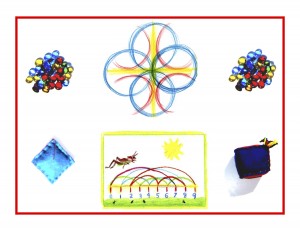Day 77
For one year, 365 days, this blog will address the Common Core Standards from the perspective of creating an alternate, ambient learning environment for math. Ambient is defined as “existing or present on all sides, an all-encompassing atmosphere.” And ambient music is defined as: “Quiet and relaxing with melodies that repeat many times.”
Why ambient? A math teaching style that’s whole and all encompassing, with themes that repeat many times through the years, is most likely to be effective and successful. Today’s post will address the “Speaking and Listening” segment of the CCSS Language Arts Standards for Grade 1. All eight of these standards are covered by the stories that are told to and retold by the child(ren) and they will all be listed in blue, then related to the storytelling and retelling.
CCSS.ELA-LITERACY.SL 1.1
Participate in collaborative conversations with diverse partners about grade 1 topics and texts with peers and adults in small and larger groups.
CCSS.ELA-LITERACY.SL 1.1A
Follow agreed-upon rules for discussions (e.g., listening to each other with care, speaking one at a time about the topics and texts under discussion.)
CCSS.ELA-LITERACY.SL 1.1B
Build on others’ talk in conversations by responding to the comments of others through multiple exchanges.
CCSS.ELA-LITERACY.SL 1.1C
Ask questions to clear up any confusion about the topics and texts under discussion.
Collaborative conversations occur quite naturally and regularly as the child(ren) retell the story the next day. Each and every detail is recounted almost verbatim as the entire story is carefully pieced together.
A) Amazingly, no rules are needed because the story is so compelling it carries the day by eclipsing any need or desire to digress! Turns are taken quite readily as the need to be true to the story wins out over attention-getting or stepping on each other’s toes.
B) Multiple exchanges happen as the story is pieced together. At this age it is unreasonable to expect a more mature mode of conversation, so instead the wonderfully complex exchanges and conversations found in any and all of the fairy tales provide a warm, nurturing cloak that protects the young child as s/he learns by example how to relate to others.
C) Not many questions are asked in the process of retelling because the story is accepted by the child(ren) as all of a piece. Appropriate to this age, the story acts as a security blanket, demanding little while providing a “whole cloth” picture of the world the child is growing into.
CCSS.ELA-LITERACY.SL 1.2
Ask and answer questions about key details in a text read aloud or information presented orally or through other media.
See (C) above.
CCSS.ELA-LITERACY.SL 1.3
Ask and answer questions about what a speaker says in order to gather additional information or clarify something that is not understood.
See (C) above.
CCSS.ELA-LITERACY.SL 1.4
Describe people, places, things, and events with relevant details, expressing ideas and feelings clearly.
All of the above are recounted in total recall and exact, relevant detail as the story is retold. The child is able to express (purely empathetically) the ideas and feelings of the characters in the fairy tale. This is all taken in on a very deep level, not yet made conscious or abstract because to do so would be beyond the intellectual and emotional capacity of the 6-7 year old. Extracting these feelings and ideas before the child has reached readiness is damaging and must be avoided.
CCSS.ELA-LITERACY.SL 1.5
Add drawings or other visual displays to descriptions when appropriate to clarify ideas, thoughts, and feelings.
After the story is retold, the child follows the teacher’s guidance to draw and caption an illustration of it. A number or letter, closely related to the story, is drawn on the facing page. Cloaking the letters and numbers in the beauty of the fairy tale protects the child’s not yet mature intellect by acting as a buffer, concretizing otherwise abstract concepts. (See this blog, Day 76 for Piaget’s recommendations re intellectual readiness.)
CCSS.ELA-LITERACY.SL 1.6
Produce complete sentences when appropriate to task and situation.
the Waldorf first grader learns to read through writing, beginning with copying the stories’ captions in complete sentences. With Waldorf, learning to read is not rushed, often waiting until Grade 3. My daughter, a Waldorf student from Grades 1-8, did not read independently until then, when she jumped right into chapter books, with no need for primary readers.
Knowledge ensues in an environment dedicated to imaginative, creative knowing, where student and teacher alike surrender to the ensuing of that knowledge as a worthy goal. More CCSS ELA Standards tomorrow!












